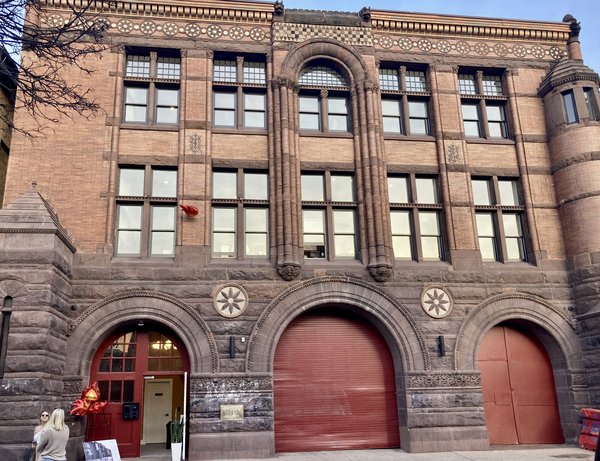An Olde Kensington firehouse built in 1895 and recognized for its architectural significance has been converted into an apartment building with 29 units and ground-floor commercial space.
The three-story building at 1221 N. Fourth St., just above of Girard Avenue, was originally the home of Engine Co. No. 29. It was designed by architect John T. Windrim, whose other notable works in Philadelphia include the Franklin Institute and the Lincoln-Liberty Building, at 1 S. Broad Street. The firehouse is considered a rare example of an intact building in the Richardsonian Romanesque style, which had revived Medieval design elements like round arches and heavy masonry facades.
MORE: Phillies join Comcast Spectacor's $2.5 billion development plan for Sports Complex
Developers Jeffrey Tubbs and Jim Maransky bought the old firehouse from the Philadelphia Redevelopment Authority for $1.6 million and their team completed the renovations over a three-year period. The original structure now contains nine apartments, with another 20 units constructed on a five -story addition at the rear of the property.
Tubbs said he's in talks with potential tenants to move into the 3,500-square-foot commercial space on the building's ground floor, but he declined to provide more details about what business could be coming there.
The market-rate apartments that are now leasing include a mix of one-bedroom, two-bedroom and loft units that each have different floor plans and features. Some apartments have 20-foot ceilings. Others have arched windows and custom spiral staircases. The one-bedroom units are 480 to 595 square feet and start at $1,575 per month. Corner one-bedroom apartments are about 739 square feet and start at $2,250. And rent for loft units, ranging from 767-1,001 square feet, start at $2,500.
A communal terrace covers a ground-floor parking area that fills the space between the firehouse and the rear addition, which fronts Orianna Street. Green rooftops currently are being installed to offer more amenities for tenants, who are expected to begin occupying the building in April.
Some of the interior walls display photographs and other artifacts celebrating the history of Engine 29.
"The work to redevelop the property was extensive," Tubbs said, "but we really tried to preserve as much of the building's history and its stories as we could."
For much of the 19th century, Philadelphia's volunteer fire stations still operated independently as part of the Union Fire Co. established by Benjamin Franklin in 1736. Then the formation of the city's fire department in 1870 sparked a new era of station construction that showed off distinctive civic architecture.
Engine 29 was established in 1883 with 12 employees assigned to a different station at 1048 N. Lawrence St., which has since been demolished. The company's new station was built at the beginning of a time considered the golden age of firehouse design. Records show the lot was purchased for $13,000 in 1894. The building was completed the next year at a cost of $30,611.07 (about the equivalent of $1.13 million today) and shared with Ladder Co. 7.
Tubbs said the cost of the adaptive reuse of the building totaled about $6 million.
The building features brownstone cladding and Roman brick with terra cotta detailing above. Although the recent renovation required replacing the red doors on the archways, the sculptures and other detailing on the facade have largely been preserved. Just above the northernmost archway is a dragon that once greeted firefighters as they entered the station.
"There were a lot of details on the front facade that we basically took damaged pieces out and created molds that were fabricated to replace them," Tubbs said.
The building's back wall was preserved, and the rear of the property is where, through the early 1920s, Engine 29 had stables for the horses that once pulled the fire company's equipment. The rear parking lot where the addition now stands was a grazing area for the horses. During its existence, the station went through several generations of engines as fire service technology evolved in the 20th century.
It remained in use until 1979, when the company moved to its current home at Fourth Street and Girard Avenue. By that time, the archways above the firehouse doors could no longer accomodate bigger fire trucks and more modern apparatus.
Engine Co. No. 29 was added to the city's Register of Historic Places in 1989. Its nomination to the National Register of Historic Places is still under review.
Tubbs and former Philadelphia Eagles player Connor Barwin are the leaders of the Make the World Better Foundation, a nonprofit that has revitalized several city playgrounds in recent years. They've fixed Smith Playground in Girard Park, Waterloo Playground in Kensington and Ralph Brooks Park in Point Breeze. Their renovation of Vare Recreation Center in Grays Ferry is expected to be finished in the coming months.
The firehouse project in Olde Kensington includes a plan to revitalize Thomas Hart Park, a pocket park located one block north at 1315-21 N. Fourth St.
"We've been going through an extensive amount of participatory design with the community," Tiffany Millner, an architect with Tubbs' JDT International, said during a recent open house.
The developers are working with Philadelphia Parks & Recreation, Friends of Hart Park and Hinge Collective to secure funds and advance plans for the park. To date, the project has raised about $400,000 and still has about $350,000 to go. Another aspect of the project was the creation of the Orianna Community Garden on an existing vacant lot directly adjacent to Hart Park and owned by the Philadelphia Land Bank. There will also be a community benefits agreement with South Kensington Community Partners.

